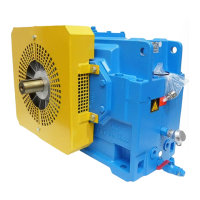104 / 109
BA 5846 en 05/2015
10.2.9 Check cooling coil
• Shut off the coolingwater supply.
• Disconnect the water in and outflow pipes from the cooling coil.
• Check the inside wall of the cooling coil for deposits.
DANGER
Risk of explosion
Ignition of a potentially explosive atmosphere possible through overheating of the gear unit due to
insufficient cooling.
If the cooling coil is dirty, heat is no longer withdrawn effectively from the gear unit. Any dirt adhering to
the inside of the cooling coil should be removed by chemical cleaning or the cooling coil should be
replaced with a new one.
If thick deposits have formed on the inside of the cooling coil, the cooling water and/or the deposits
themselves should be chemically analysed. Such analyses are offered by specialist companies for
chemical cleaning. Such companies also sell special cleaning agents for removing such deposits.
Before using these cleaning agents, check that they will not damage the coolingcoil materials (contact
Siemens). Observe the manufacturer’s instructions at all times when using different cleaning agents from
several manufacturers.
CAUTION
Risk of corrosion burns through chemical substances
Avoid burns when working with corrosive cleaning agents
Observe manufacturer’s instructions for handling lubricants and solvents.
Wear suitable personal protective equipment (gloves, safety glasses).
• Seriously contaminated cooling coils must be replaced. Consult the Siemens Customer Service for
this.
• Reconnect the coolingwater in and outflow pipes.
10.2.10 Check hose lines
Even when adequately stored and subjected to permitted loads, hoses and hose lines are subject to
a natural ageing process. This limits their period of use (service life).
NOTICE
Material damage
Risk of damage to the hose lines through excessive ageing or external influences.
The period of use of the hose lines must not exceed 6 years.
For checking purposes, the manufacturing date is printed on the hose lines.
If a fault is found during inspections, this must be rectified immediately.
The period of use can be determined using available test results and empirical values, taking into account
the conditions of use.
Note
The operator of the system must ensure that hose lines are replaced at suitable intervals of time, even
if no defects which may affect their safe operation are identifiable on them.
Hose lines must be inspected for safe working condition by an expert before the plant is first put into
operation and thereafter at least once a year.

